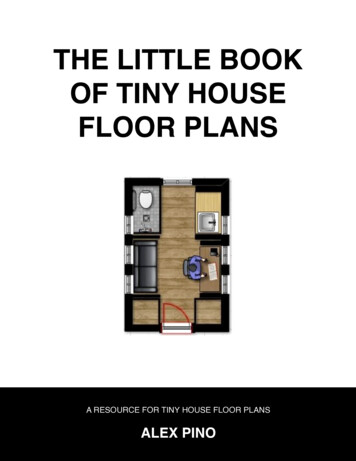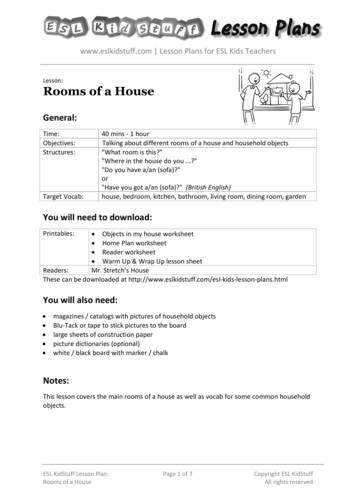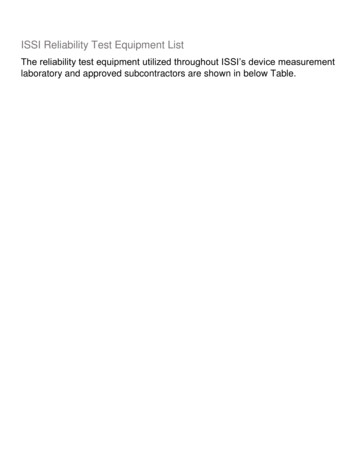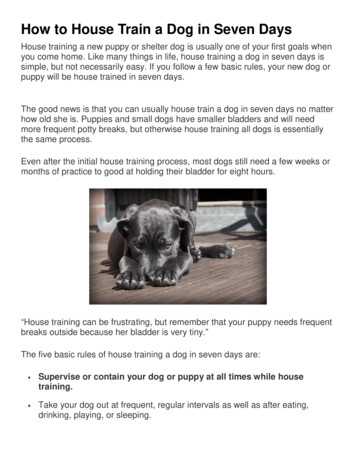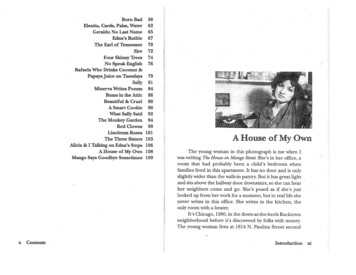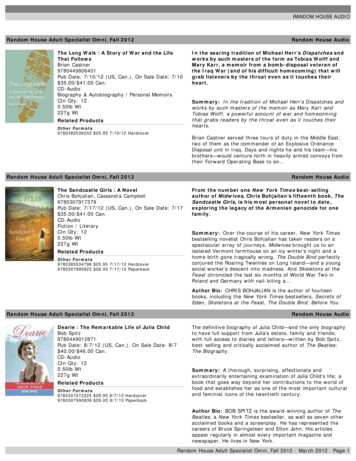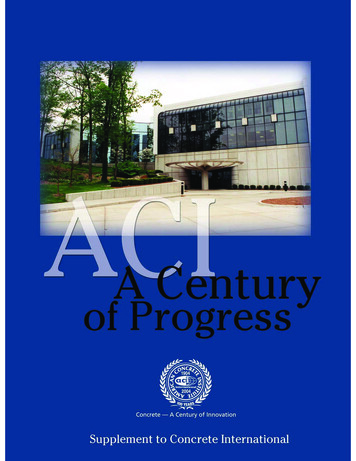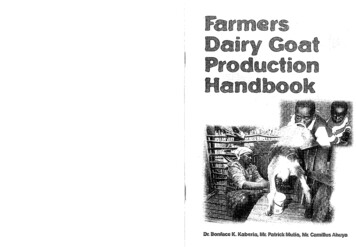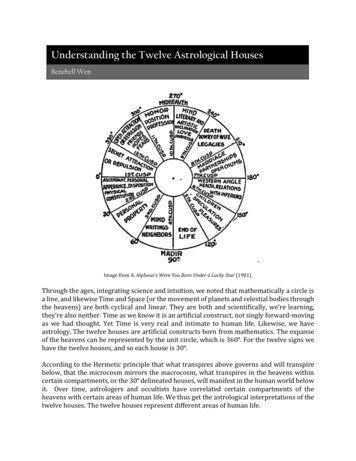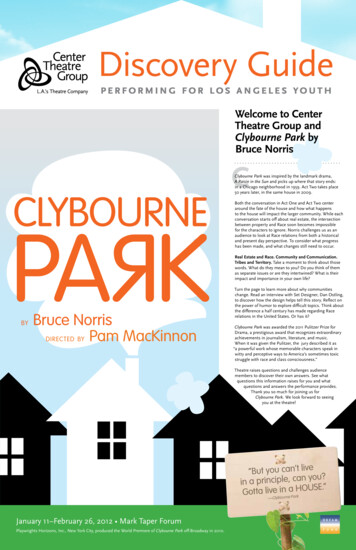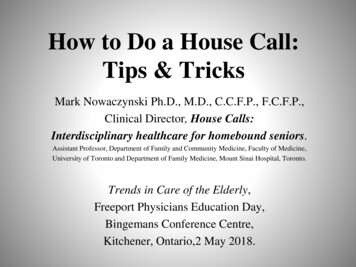
Transcription
How to Do a House Call:Tips & TricksMark Nowaczynski Ph.D., M.D., C.C.F.P., F.C.F.P.,Clinical Director, House Calls:Interdisciplinary healthcare for homebound seniors.Assistant Professor, Department of Family and Community Medicine, Faculty of Medicine,University of Toronto and Department of Family Medicine, Mount Sinai Hospital, Toronto.Trends in Care of the Elderly,Freeport Physicians Education Day,Bingemans Conference Centre,Kitchener, Ontario,2 May 2018.
How to do a house call: tips and tricksDr. Mark NowaczynskiFreeport Physicians’ Education DaysDeclaration of Conflict of Interest Relationships with commercial interests:––––Grants/Research Support: NoneSpeakers Bureau/Honoraria: NoneConsulting Fees: NoneOther: None I do not intend to make therapeuticrecommendations for medications that have notreceived regulatory approval (e.g. off label use)
How to do a house call: tips and tricksDr. Mark NowaczynskiGoal: To review the practice of primary care medicinedelivered in an out-of-clinic setting.Objectives:1. Participants will understand the challenges of home-basedmedicine2. Participants will be able to identify methods ofcircumventing these challenges.3. Participants will review the effectiveness of home-basedprimary care4. Participants will understand how home-based care impactspatients' health and quality of life life.
1948 W. Eugene Smith
Telemedicine good for remote specialist consults cannot replace in-person encounters can be used to monitor patients– but not as a substitute for Home-Based PrimaryCare
“Technology in general, just like pornography,offers us lousy models for connecting andbonding with other people.”Dr Sue Johnson, Love Sense
Two Conflicting Challenges: Growing numbers of house-bound patients Majority of physicians are office-bound
Home-based care, why is it important? frail seniors are eventually unable to makeoffice visits to doctors – “lost to follow-up” bounce in and out of emergency departments more hospital admissions and re-admissions more prolonged hospital stays (ALC) increased rates of institutionalization home care and home-based primary careare highly preventative, and cost-effective
Why should we care? demographic tsunami.
In the 2 decades between 2010-2030: number of Canadians over 65 will double number over 85 will quadruple
Canada’s Universal Health Care System: Designed over 50 years ago– average Canadian was 27 years of age Today the average age is approaching 50 Our health care system was not designed tomeet the needs of an aging population
Alternate Level of Care (ALC): On any given day15% of acute care hospitalbeds in Canada are occupied by ALC patients(mostly seniors)– (ALC patients who no longer need to be inhospital, but have nowhere else to go) Costs 2.3 billion/year to warehouse seniors inhospitals– Equals the entire Ontario home care budget!
Average daily costs: Hospital bed 1,000/day LTC bed 150/day Home Care 50/day
Health Care Spending: Today 14% of Canadians are over 65, andaccount for 45% of public health carespending By 2036 seniors will comprise 25% of thepopulation and 62% of health care costs
We need to provide care to seniorsdifferently: REDUCE avoidable hospitalizations Shift focus of care from hospitals back into thecommunity:– Home & Community Care– Home-Based Primary Care– Home Palliative Care
Supportive Homecare:
Home Based Primary Care:
Interprofessional Care:
Specialty Care:
House Calls – home-based primary care: pilot project 2007, program funding 2009 House Calls provides ongoing comprehensiveinterdisciplinary home-based primary care to frail,marginalized, cognitively impaired, and house-boundseniors who would not otherwise have access toprimary care.– whose needs cannot be met by typical office-basedprimary care delivery– Home visits become a necessity, not just a convenience. embedded in a Community Support Services Agency(SPRINT Senior Care), allowing a comprehensivebasket of services to be integrated with primary caredelivery.
Do you remember these guys?
House Calls are: Low tech, high touch adhere to the KISS principle HBPC is not unlike the 4077th M*A*S*Happroach to surgery:––––it’s a team effort, close to the frontyou Dx & treat based on your Hx and Px examinvestigations are limitedyou are not often sending your patient to ER you deal with issues then and there!– early intervention prevents deteriorations thatresult in admissions & readmissions
Who are our patients? A heterogeneous group of medically,cognitively and socially fragile elders whoseneeds are not well served by traditionaloffice-based primary care delivery. “House-bound” is a concept– Who benefits from home-based primary care?– What do our patients really look like?
Who are our patients? - SNAP Tool:
House Calls 2009 – 2018: 2,000 patients enrolledcaseload 350 (80 in 2009/2010, 135/yr))average age 87-89annualized caseload 500-600 (and growing)40% referred from hospitalmultiple comorbiditieshigh rate of attrition5,000 medical home visits/year8,000 – 10,000 total home visits/year
House Calls attrition: 2 end-points that constantly remindus of our mortality:
Evidence Supporting House Calls Model: Study of 150 patients enrolled into House Callsfollowing an index acute care hospitalization– average age 87 125 patients active in program 90 days– 53% fewer hospital admissions per year– 67% annual reduction in days in hospital Reduction of 17,000/patient/year in hospital costs House Calls program costs 2,600/patient/year
House Calls Return On Investment (ROI)? Cost of combined interprofessional andmedical care provided by House Calls– 2,600/patient/year House Calls saves 5-10M/year in hospitaland institutional care Hundreds of thousands of dollars of HomeBased Primary Care prevents millions ofdollars in hospital and institutional care
House Calls: Teaching & Training: Clinical Placements (OT, SW, RN, NP, MD) Sept 2009 – present:– 100’s of trainees have had placements with HouseCalls Former Family Medicine residents who trained withHouse Calls now provide ongoing home-based geriatricprimary care.
How are house calls done?:- Equipment- The Clinical Encounter
Equipment - what’s in the bag?
Medical equipment:
Mobile office:
The Clinical Encounter: History– Supports in place? Caregivers, family, neighbors CCAC & home care supports– POA? PGT
The Clinical Encounter: History Medication review and reconciliation– physically look at pill bottles or blister-packs– have your patient show you what they are actuallytaking
I am a big fan of blister-packs: simplify administrationincrease patient complianceeasy to monitor compliancemedication review and reconciliation at aglance PSWs can assist with blister-packs, but not pillbottles
Blister-pack:
Falls prevention is key: Hip # - 50% mortality within 6 months “OT Magic”– Home care referral for ‘home safety & mobility’
The Clinical Encounter: History Medication review and reconciliation Physical exam– Percuss!!!– Mobility & transfers– Cognitive assessment MMSE, MOCA, Mini-Cog
The Clinical Encounter: HistoryMedication review and reconciliationPhysical examExamine surroundings–––––fridge biopsycleanliness (smell), infestationssleeping, bathroomequipment (walker, wheelchair, Saska pole etc).stairs, railings, little rugs, safety, falls risk etc.
What were the 2 most importantthings we needed to do for thiswoman?
Sometimes the post powerfulintervention of all- is to order Meals on Wheels!
The Clinical Encounter: HistoryMedication review and reconciliationPhysical examExamine surroundingsInvestigations– can order lab to collect blood & urine
The Clinical Encounter: HistoryMedication review and reconciliationPhysical examExamine surroundingsInvestigationsDiagnosis– problem list
The Clinical Encounter: HistoryMedication review and reconciliationPhysical examExamine surroundingsInvestigationsDiagnosisTreatment– medical, rehab, social, supports & services etc.– future care planning, advanced directives, POA
Case Study: Clarence H.
Referral Info: Referred by Meals on Wheels– MOW volunteers noticed progressive decline. Clarence consented to physician home-visit90 yrs old.Lives alone.House-bound.
1st visit Clarence is a bright, articulate, and cognitivelyintact retired accountant. Stubborn and fiercely independent. House is neglected and dirty has been living here for over 70 yrs. Widowed x 30 yrs. Limited supports– step-grandson does weekly shopping.
Past Medical History: No family physician contact x 30yrs. Fractured ankle 4 yrs. ago– seen in ER & Fracture Clinic.– hospital SW referred him to MOW.
Observations & Recent Hx: Thin and frail. Poor mobility – wall and furniture walking. 2 story house, bathroom & bedroom 2nd floor,steep staircase, no hand rail. Increasing fatigue x months Tires easily, SOB, SOBOE, nocturia x 4 or 5.
Physical Exam: RR 24/minH&N: N.Chest: mild bibasilar cracklesBP: 140/80, HR 100, irreg irregCVS: JVP 5-6cm SA, HJR ve, normal HS,no M, pitting to knees. Abdo: N.Impression: CHF, a.fib, frail, falls risk.
Initial treatment & Investigations: Start bisoprolol 2.5mg qAMStart furosemide 10mg qAMUrgent B/W drawn by MDRefuses PSW support.Will “think about” OT referral for home safetyassessment & falls prevention.
One week later: 2nd visit Pt reports “feeling a little less tired – more getup and go”. Reports decreased SOB but “easily tired whenI do anything protracted”. Decreased SOA
O/E: RR: 16-20/min (down from 24/min)BP: 110/70, HR 70 (irreg/irreg)Chest: clearCVS: JVP 3-4cm SA, pitting ½ to knees.
Blood Work: Normal lytes U&Creat.Normal Hgb, TSH etc.Glucose 20HgA1c 0.110
Additional Medical Management: Start metformin 500mg with supper Start ramipril 1.25mg qAM Start ASA 81mg od (refuses anticoagulation)
One week later: 3rd visit: Tolerating Rx. Energy level improved – “not bad, I have beenable to move around”. No SOB, decreased SOA. Decreased nocturia to 1/night - “vastlyimproved”. Feeling better – “my acuity is a bit moresharpened”.
O/E: RR 16/minChest: clearBP: 130/70, HR 70CVS: JVP 3-4cm SA, pitting ½ to knees.
Additional Medical Management: Increase ramipril to 2.5mg qAM Increase metformin to 500mg bid Continue furosemide 10mg, bisoprolol 2.5mg,EC ASA 81mg.
One Week Later: “Overall I feel Ok”. No SOB, walking better, denies SOBOE.O/E:BP: 110/65, HR 70 irreg irregChest: clearCVS: JVP 3cm SA, mild pitting 1/3 to knees.
Eventually Agrees to OTAssessment: Refuses to try walker. Refuses to install hand rail. Accepts to live at risk with increased falls risk.
Over Next Two Years: Compliant with RxCHF & NIDDM well controlledrefuses any additional supportsRefuses all OT recommendations
House Calls: respectful and dignifiedpatient centereda lovely way to combat ageismadvocate for your patientsbecome a role model– take medical students and residents with you onhome visits
Advantages to the provider: very satisfying– Provide care to those who would otherwise havegreat difficulty accessing care really get to know your patients & families visits are largely provider driven– YOU control who you visit escape the clinic and the “worried well”get to know your cityimprove your parking skillsdo some walking & cycling
Some parting thoughts: Main entry Points into the Health Care System:– ERs & hospitals– Medical offices & Outpatient Clinics What about home?– Home Care– Home-Based Primary Care– Palliative Care at home
Where and howdo you want tolive- out yourdays?
Sep 05, 2020 · Dr Sue Johnson, Love Sense. Two Conflicting Challenges: Growing numbers of house-bound patients Majority of physicians are office-bound . Home-based care, why is it important? frail seniors are eventually una
